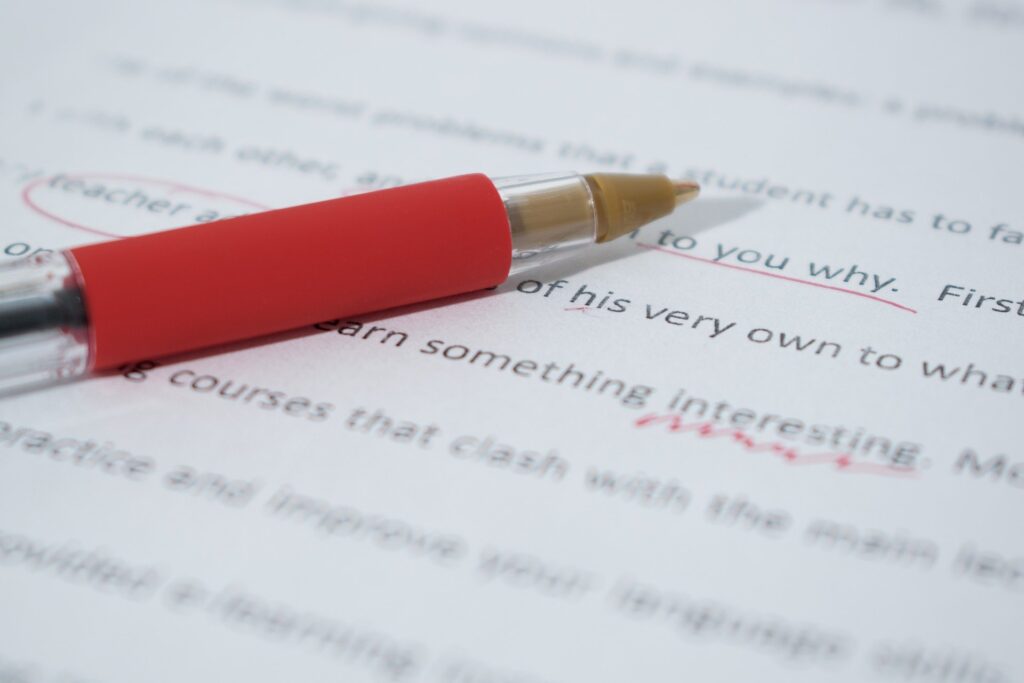
What’s the difference between proofreading, copyediting, and rewriting?
They’re all services that will improve the quality of your work, but which one do you actually need?
People often ask for proofreading when they’re actually looking for more than that. With a little extra time, a copywriter (like me!) can tidy up your work to a professional standard – either by improving what’s already there, or by completing rewriting it from scratch.
Let’s go through a few examples…
Proofreading
To demonstrate, here is a fictional example of some marketing copy from a skincare brand.
Before proofreading:
We are skin care brand, aiming to create hi-quality products. We make product with inovative formulations. Our hand made products have proved results too improve skin condition. We use naturally extracts for healthy and youthfull skin, including Dead Sea Salt for revolutionery skin care products.
As you can see, there are several errors relating to spelling and grammar. This conveys an unprofessional image, which can be off-putting to potential customers. Even if you’re confident with writing, you might not spot your own mistakes.
A proofreader will notice and fix these errors, as shown below:
After proofreading:
We are a skincare brand aiming to create high quality products. We make products with innovative formulations. Our handmade products have proven results to improve skin condition. We use natural extracts for healthy and youthful skin, including Dead Sea Salt, for revolutionary skin care products.
After proofreading, the text is error-free – which, in some cases, is all that’s required.
But if you want the whole thing to sound better, we can take it a step further by working on the vocabulary, tone, and structure of the text. Read on to discover the difference between proofreading and copyediting.
Copyediting
While proofreading simply checks for mistakes, copyediting (also known as ‘copy editing’ or ‘copy-editing’) is a more intensive service that takes substantially more time. As well as correcting errors, words and sentences may be modified to improve the overall syntax – this could involve a few minor tweaks or substantial editing of the original document.
Put simply, copyediting a document will make it “sound better”.
It can be likened to waving a magic wand over your words to transform them into something more professional, more engaging, or more concise.
Let’s use the same piece of text as an example to demonstrate the difference between proofreading and copyediting.
After proofreading, the text is error-free – but with a little extra tweaking it could sound a lot better.
Before copyediting:
We are a skincare brand aiming to create high quality products. We make products with innovative formulations. Our handmade products have proven results to improve skin condition. We use natural extracts for healthy and youthful skin, including Dead Sea Salt, for revolutionary skin care products.
After copyediting:
We are a revolutionary skincare brand that creates high quality products with innovative formulations. With proven results, our handmade products contain natural extracts – including Dead Sea Salt – to improve the condition of your skin.
Without significantly altering the original words of the author, I have adapted four stilted sentences into something that flows more naturally. As a result of these minor changes, the revised text is punchier and more succinct.
Rewriting
Sometimes a piece of text needs to be completely rewritten from scratch. This may be required if the quality of the original is not sufficient – for example, if it’s written in broken English. Depending on the objective, some specific words or phrases may be retained.
Rewriting can also be useful in circumstances where an original piece of copy needs to be expressed in unique ways – for example, across different websites.
Again, we’ll use the same example of some fictional marketing copy for a skincare brand.
Before rewriting:
We are a skin care brand aiming to create 21st century technology products. We make products with innovative formulations. Our hand made products have proven results to improve the condition of your skin. We use natural extracts for healthy and youthful skin, including Dead Sea Salt, for revolutionary skin care products.
While the spelling is technically correct, the text doesn’t read well. Three of the four sentences begin with the word “we”, which sounds repetitive and stilted. The word “products” is overused and appears in every sentence. Lack of variety and too much repetition results in copy that sounds dull and lacklustre.
With a little help, these words can be completely rewritten and transformed into something that’s more exciting to read.
After rewriting:
Unlock the secret to youthful radiance with XXX. Our innovative formulations combine natural extracts with 21st century technology for high-performance skincare with proven results. By harnessing the natural power of the Dead Sea, XXX has revolutionised the age-defying skincare industry. Are you ready to reveal the true beauty of your skin?
Both examples contain the same number of words (51), but the latter presents a more polished and professional image.
While the original text was factually acceptable, it lacked pizzazz and failed to engage the reader. With the help of a professional copywriter, dull text can be elevated into something that more accurately represents your brand.
Which service do you need?
I hope this article has helped to demonstrate the differences between proofreading, copyediting, and rewriting.
If you’re still not sure which service you require, feel free to send me an email for further advice and/or a quote.